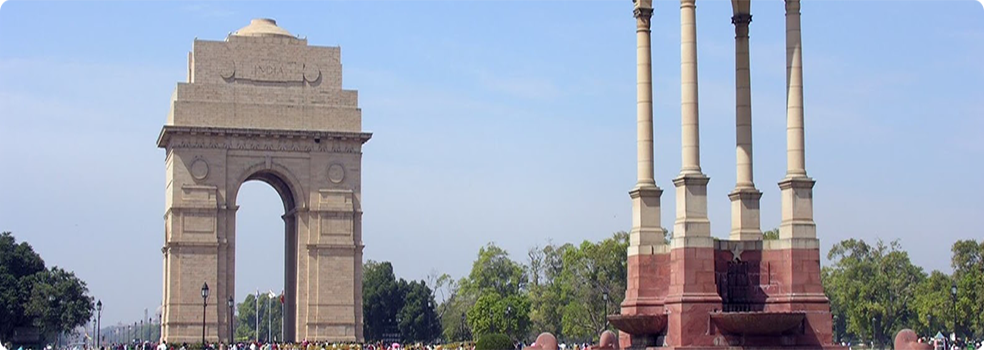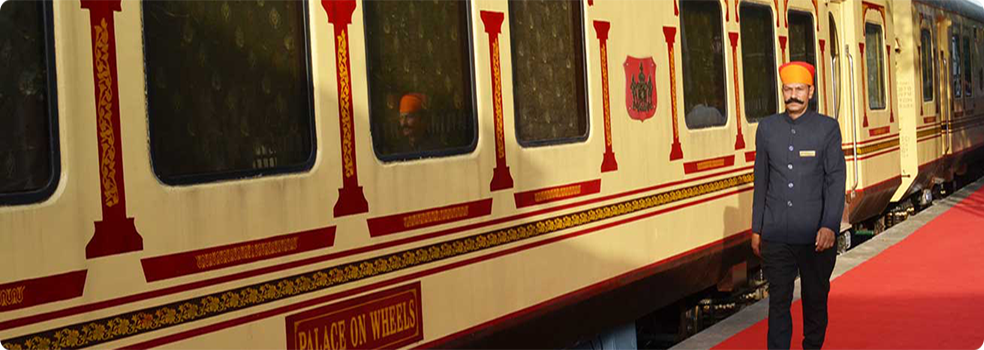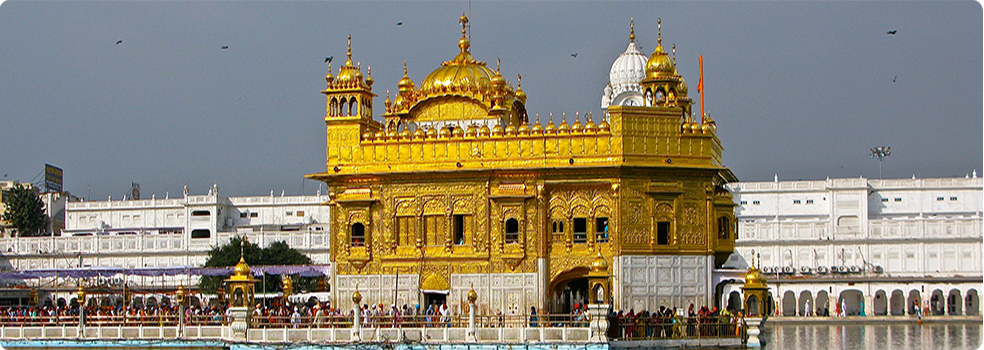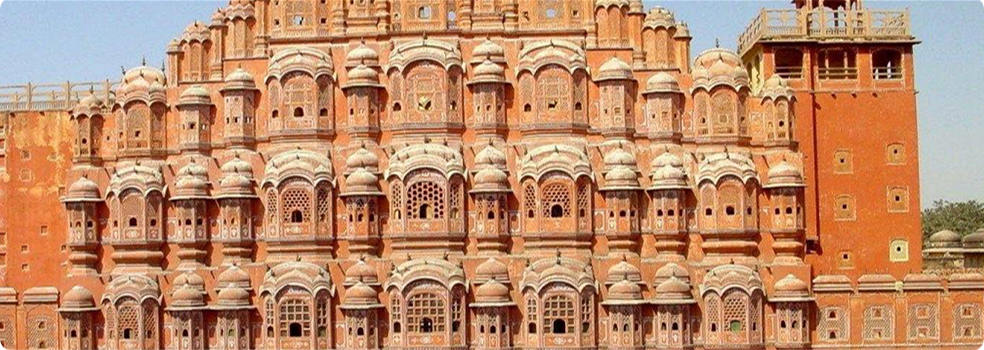-
Rajasthan Tour Packages
- Rajasthan Camel Safari Tour Package
Duration : 11 N / 12 D - Palace On Wheels Tour Package
Duration : 07 N / 08 D - Rajasthan wildlife Tour Package
Duration : 09 N / 10 D - Rajasthan Tour Package
Duration : 09 N / 10 D - Rajasthan Forts & Palaces Tour
Duration : 13 N / 14 D - Rajasthan Heritage Tour Package
Duration : 21 N / 22 D - Pushkar with Taj Mahal Tour package
Duration : 04 N / 05 D - Jaipur & Ranthambore Tour Package
Duration : 06 N / 07 D - Rajasthan Desert Triangle Tour
Package Duration : 05 N / 06 D - Elephant Safaris Tour Package
Duration : 03 N / 04 D - Rural Rajasthan Tour Package
Duration : 22 N / 23 D - Rajasthan Tiger Trails Tour Package
Duration : 06 N / 07 D - Colourful Rajasthan Tour Package
Duration : 12 N / 13 D - Rajasthan Desert Circuit Tour Package
Duration : 10 N / 11 D - Rajasthan Pilgrimage Tour Package
Duration : 13 N / 14 D
- Rajasthan Camel Safari Tour Package
-
Rajasthan Honeymoon Packages
- Rajasthan Honeymoon Tour
Duration : 03 N / 04 D - Rajasthan Honeymoon Tour Package
Duration : 09 N / 10 D
- Rajasthan Honeymoon Tour
-
Golden Triangle Tour Packages
- Same Day Taj Mahal Tour Package
Duration : Same Day - Delhi Agra Jaipur Tour Package
Duration : 05 N / 06 D - Golden Triangle With Rishikesh
Duration : 07 N / 08 D - Golden Triangle with Khujraho wildlife
Duration : 09 N / 10 D - Golden Triangle with Pushkar
Duration : 06 N / 07 D - Golden Triangle Golden Temple
Duration : 04 N / 05 D
- Same Day Taj Mahal Tour Package
-
Varanasi Tour Packages
- Delhi Varanasi Tour Package
Duration : 05 N / 06 D - Delhi Mathura Vrindavan Agra Tour
Package Duration : 05 N / 06 D
- Delhi Varanasi Tour Package
-
Car Tour Packages
- Delhi Agra Same Day Car Package
Duration : Same Day - Delhi Agra Jaipur Car Package
Duration : 02 N / 03 D
- Delhi Agra Same Day Car Package
-
Volvo Tour Packages
-
Rajasthan Tourist Places
- Jaipur
Rajasthan Tourist Place - Udaipur
Rajasthan Tourist Place - Jodhpur
Rajasthan Tourist Place - Ajmer
Rajasthan Tourist Place - Mount Abu
Rajasthan Tourist Place - Jaisalmer
Rajasthan Tourist Place - Bikaner
Rajasthan Tourist Place - Bharatpur
Rajasthan Tourist Place - Ranthambore
Rajasthan Tourist Place - Pushkar
Rajasthan Tourist Place
- Jaipur
-
Hotels In Rajasthan
- Hotels In Jaipur
Hotels In Jaipur - Hotels In Udaipur
Hotels In Udaipur - Hotels In Jodhpur
Hotels In Jodhpur - Hotels In Ajmer
Hotels In Ajmer - Hotels In Mount Abu
Hotels In Mount Abu - Hotels In Jaisalmer
Hotels In Jaisalmer - Hotels In Bikaner
Hotels In Bikaner - Hotels In Bharatpur
Hotels In Bharatpur - Hotels In Ranthambore
Hotels In Ranthambore - Hotels In Pushkar
Hotels In Pushkar
- Hotels In Jaipur
-
Hotels In Delhi
- Hotels In Delhi
Hotels In Delhi
- Hotels In Delhi
-
Hotels In Mathura & Vrindavan
- Hotels In Mathura
Hotels In Mathura - Hotels In Vrindavan
Hotels In Vrindavan
- Hotels In Mathura
-
Hotels In Varanasi
- Hotels In Varanasi
Hotels In Varanasi
- Hotels In Varanasi
-
Hotels In Haridwar & Rishikesh
- Hotels In Haridwar
Hotels In Haridwar - Hotels In Rishikesh
Hotels In Rishikesh
- Hotels In Haridwar
-
Hotels In Agra
- Hotels In Agra
Hotels In Agra
- Hotels In Agra
Jaigarh Fort, Jaipur

Playing sentinel to the old capital of Amber, legendary Jaigarh, the "Victory Fort", strategically dominates the Cheel ka Teela. Commonly perceived as one huge compound, the Jaigarh and Amber Forts are directly linked with long secured corridors. Located in the midst of prickly undergrowth, a mere glance at the fort considerably influences the viewer at once
Hawa Mahal, Jaipur

A whimsical addition to Rajasthan's rich architectural vocabulary, the fanciful Hawa Mahal or "Palace of Winds" was created in 1799 by the aesthete Sawai Pratap Singh and designed by Lal Chand Utsa. You can site this architectural splendor next to the entrance to the City Palace. Its ornate pink façade has become an icon for the city. The tiered Baroque-like composition of more than 953 projecting windows, 900 niches and balconies with perforated screens is five storey high but just one room deep, its walls not more than 20 cm thick. Built of lime and mortar, the Rajputana structure was designed in this way to enable the veiled ladies of the harem to observe unnoticed the lively street scenes below.
Amber Fort, Jaipur

The fort palace of Amber was the Kachhawaha citadel until 1727, when their capital moved to Jaipur. Successive rulers continued to come here on important occasions to seek the blessings of the family deity, Shila Devi. The citadel was established in 1592 by Man Singh I on the remains of an old 11th century fort, but the various buildings added by Jain Singh I are what constitute its magnificent centerpiece.
City Palace, Jaipur

Occupying the heart of Jai Singh II's city, the City Palace has been home to the rulers of Jaipur since the first half of the 18th century. The sprawling complex is a superb blend of Rajput and Mughal architecture, with open, airy Mughal-style public buildings leading to private apartments. Today, part of the complex is open to the public as the Maharaja Sawai Man Singh II Museum, popularly known as the City Palace Museum. Its treasures, which include miniature paintings, manuscripts, Mughal carpets, musical instruments, royal costumes and weaponry, provide a splendid introduction to Jaipur's princely past, and it's fascinating arts and crafts.
Chittaurgarh Fort

The great, battle-scarred Chittorgarh Fort epitomizes in its tragic history the valor, romance, chivalry and strict death-before-dishonor code glorified in Rajput myths and legends. Sprawling across 280 ha, atop a steep 180 m high rocky hill, Chittorgarh's ruined palaces, temples and towers bear witness to its illustrious and turbulent past, when it was the capital of the Sisodia rulers of Mewar, between the 12th and 16th centuries.
Lake Palace, Udaipur

The Lake Palace is situated on the Jag Niwas Island (in Lake Pichola of Udaipur), which offers an innate ground for the Palace. This isle was originated by Maharana Jagat Singh in the year 1754 and as such it was christened after him. The palace was also constructed by him and functioned as a seasonal palace for the large regal household. It embraces approximately the whole extent of the huge stony isle and appears to come out from the mid of the lake. The breathtaking loveliness of the palace is unrivaled with its clear mirror image in the completely clean and tidy lake making for a fine popular sight.
City Palace, Udaipur

Stretching along the eastern shore of Lake Pichola, Udaipur's City Palace is a fascinating combination of Rajput military architecture and Mughal-style decorative techniques. Its stern, fortress-like façade, topped by a profusion of graceful balconies, cupolas and turrets, has been aptly described by one writer as a massive plain cake topped with fabulous icing. The largest palace in Rajasthan, covering an area of 2 ha, the City Palace is actually a complex of several palaces, built or added to by 22 different maharanas between the 16th and 20th centuries. Much of it is now a museum, and parts of it are luxury hotels.
Jaisalmer Fort Sonar

Playing sentinel to the old capital of Amber, legendary Jaigarh, the "Victory Fort", strategically dominates the Cheel ka Teela. Commonly perceived as one huge compound, the Jaigarh and Amber Forts are directly linked with long secured corridors. Located in the midst of prickly undergrowth, a mere glance at the fort considerably influences the viewer at once.
Mehrangarh Fort, Jodhpur

Rising sheer out of a 125 m high rock, Mehrangarh is perhaps the most majestic of Rajasthan's forts. Described by an awestruck Rudyard Kipling as "the creation of angels, fairies and giants", Mehrangarh's forbidding ramparts are in sharp contrast to the flamboyantly decorated palaces within. Founded by Rao Jodha in 1459, the sandstone fort was added to by later rulers, mostly between the mid 17th and mid 19th centuries. The royal apartments within the fort now form part of an outstanding museum.
Junagarh Fort, Bikaner

Constructed between 1587 and 1593 by the third ruler of Bikaner, Rai Singh, Junagarh Fort is protected by a 986 m long sandstone wall with 37 bastions, a moat and, most effectively of all, by the forbidding expanse of the Thar Desert. Not surprisingly, the fort has never been conquered, a fact which explains its excellent state of preservation.
Taragarh Fort, Bundi

The Taragarh Fort crowns the crest of a steep hill overlooking the town, while the Garh Palace spills picturesquely down the hillside. This palace is Bundi's – and Rajasthan's – jewel. Lieutenant Colonel James Tod, (1782-1835), the British Political Agent and author of the authoritative Annals and Antiquities of Rajasthan, wrote that "the coup d'oeil of the castellated palace of Bundi, from whichever side you approach it, is the most striking in India.
Umaid Bhawan Palace, Jodhpur

This immense palace, built of creamy-pink sandstone and marble that has been put together without the use of mortar, is a prime example of princely India's opulence. Its 347 rooms include eight dining halls, two theatres, a ballroom, several lavishly decorated reception halls and a vast underground swimming pool. A 60 m (197 ft) dome covers the cavernous central hall which, at its inauguration, seated 1,000 people for dinner.












